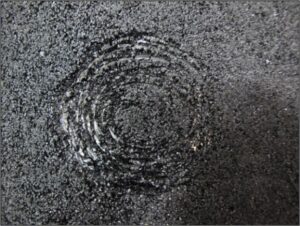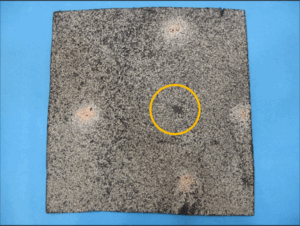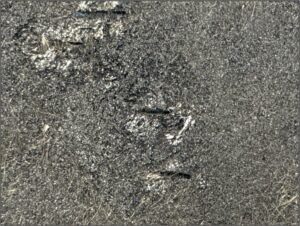Roof evaluations for hail damage often include roof core sampling and laboratory testing. For multi-ply bituminous membranes (e.g., built-up roofs and modified bitumen roof membranes), this testing commonly includes delamination testing of the membrane plies to evaluate both the plies and the interply bitumen for damage from impact forces. Figure 1 shows a clear instance of impact disturbance to interply bitumen, discovered upon delamination of the membrane. While this type of disturbance indicates that a discrete impact force was sustained, it can be caused by many different sources of impact, and such disturbances are not uniquely characteristic of hail impact.

Figure 1: Representative view of an impact disturbance at interply bitumen of a BUR sample.
Laboratory delamination testing can be an important part of hail damage evaluations for a number of reasons. One such reason was discussed in a published paper titled Hail Evaluation of Bituminous Roofing Membranes: Understanding Interply Mopping Voids. In this paper, Nelson discusses how as-built voids in the interply mopping may be mistaken for hail damage if the proper methodology is not followed in evaluation and testing. Figure 2 shows a sample with a surface anomaly and Figure 3 shows the corresponding mopping void within the membrane, which appears to have been the cause of the surface anomaly. In other cases, upward protrusions (which would not be the result of a downward impact force) are found coincident with surface anomalies.

Figure 2: Area of granule loss over mopping voids in mod-bit membrane.

Figure 3: Interply mopping void corresponding to granule loss shown in Figure 2.
A laboratory evaluator/analyst may be asked to determine if the samples have impact damage or not and to describe the conditions which exist within the membrane. However, it is important to note that this laboratory evaluator/analyst is typically independent of the site investigation and does not know the specific site conditions observed at and in the vicinity of the sample or the relevant weather data history. Therefore, a laboratory evaluator typically cannot reliably conclude that a specific impact disturbance identified in a membrane sample is specifically consistent with, or caused by, hail impact. Rather, they can establish that the disturbance exists and define the characteristics, providing data for the professional who performed the site evaluation to draw conclusions regarding hail impact.
In some cases, laboratory evaluation may be able to discern when impact damage has been sustained but from a non-hail source, such as a sharp-edged tool or other mechanical implement. Evidence of this can include distinctive sharp-edged cuts, punctures, gouges, or impressions that would not occur from a generally rounded object, such as a hailstone, or even a “knobby” or “jagged” hailstone. These conditions would be important considerations for the professional performing the site evaluation. Figure 4 shows a relatively straightforward and common example of impact distress that was not caused by hail. In this case, the interply bitumen disturbances occurred in a closely spaced series and are coincident with sharp, linear punctures of the felt, a pattern that is characteristic of punctures from a reciprocating saw.

Figure 4: Impact disturbances to interply bitumen, with coincident sharp linear punctures
It is therefore good practice for independent laboratories that perform sample testing to identify important considerations but not to engage in speculation beyond the known facts. It may be the case that a sample has impact damage; however, without detailed knowledge of the field investigation and the conditions at the site, the laboratory evaluator cannot reliably opine whether or not the impact was in fact from a hailstone.
Nelson’s team of professionals has experience evaluating roof systems and other building elements and systems for damage related to hail impact. Nelson also has extensive experience in the laboratory analysis of roof samples.

